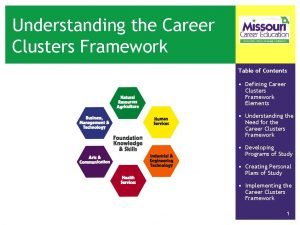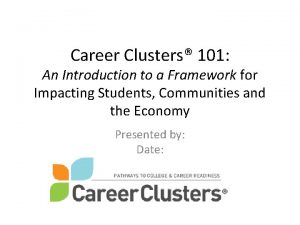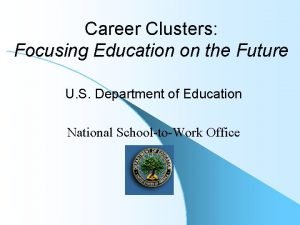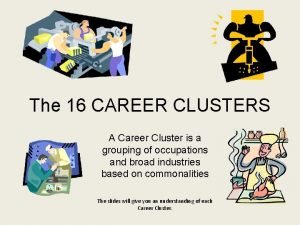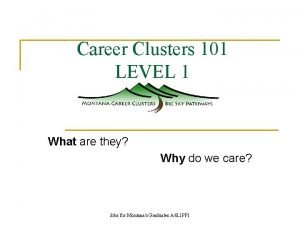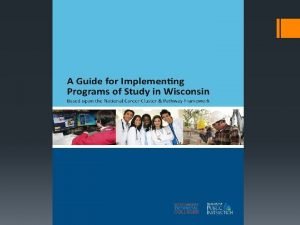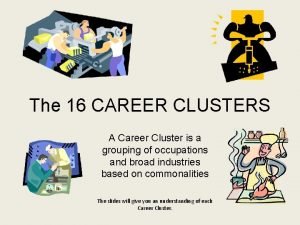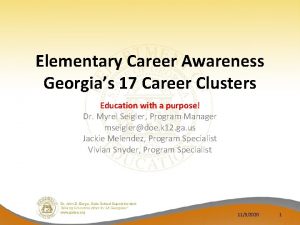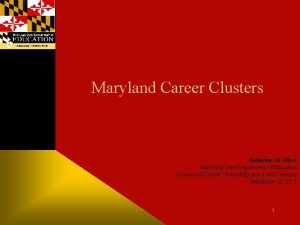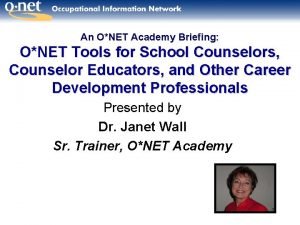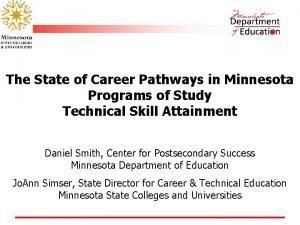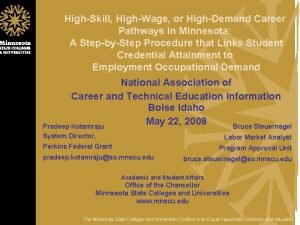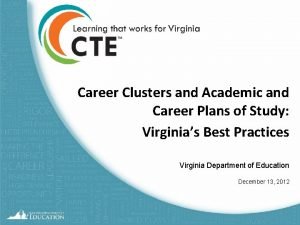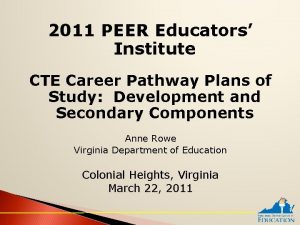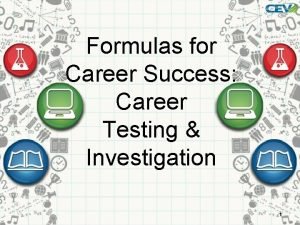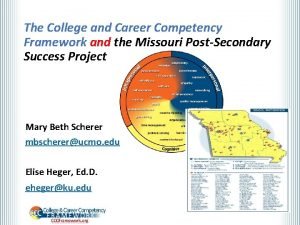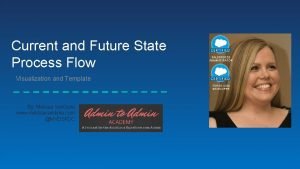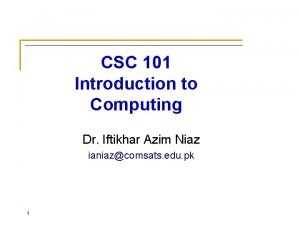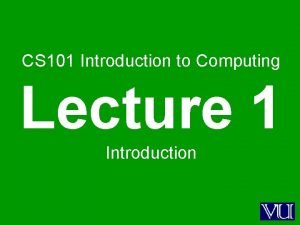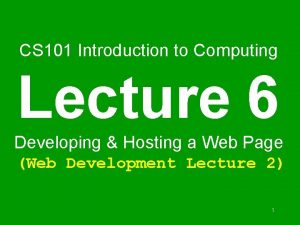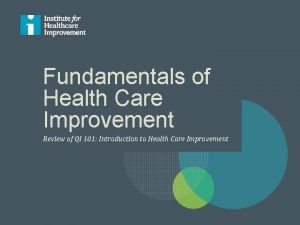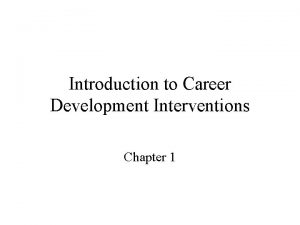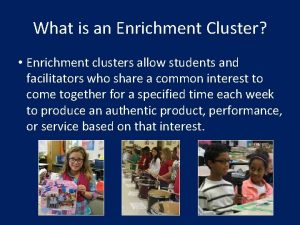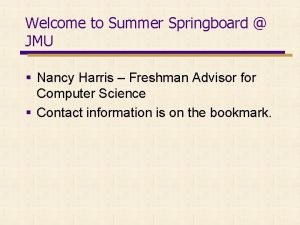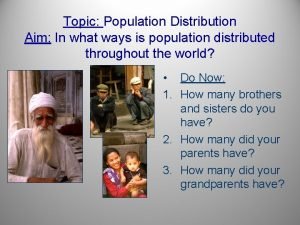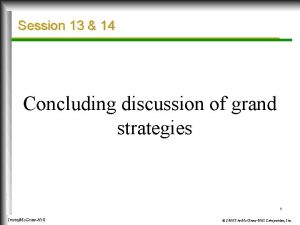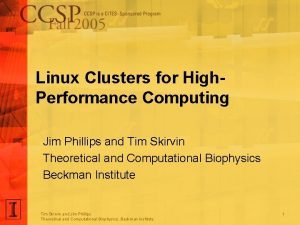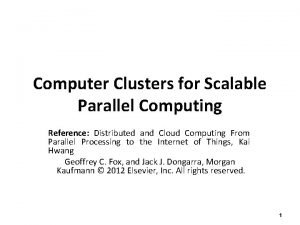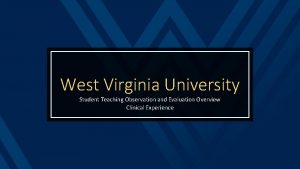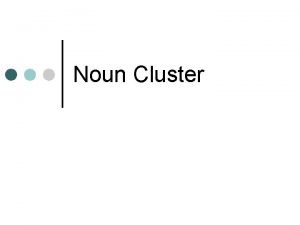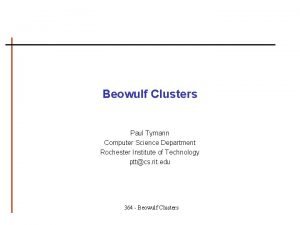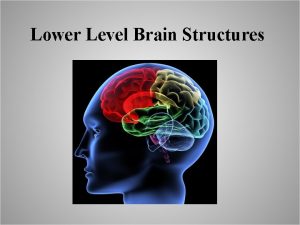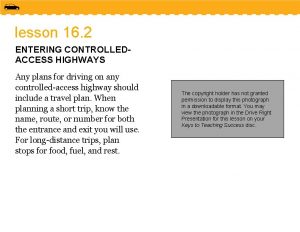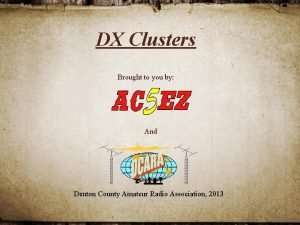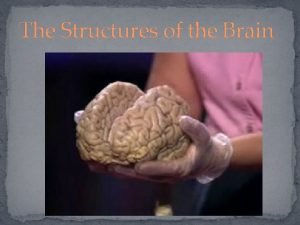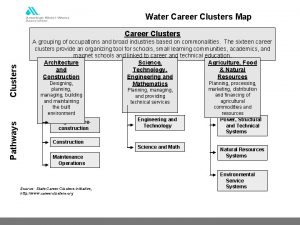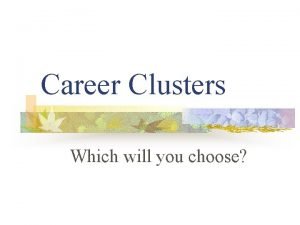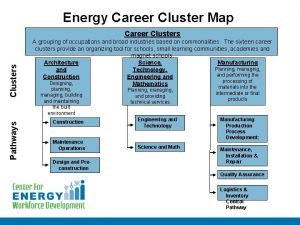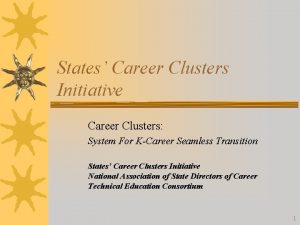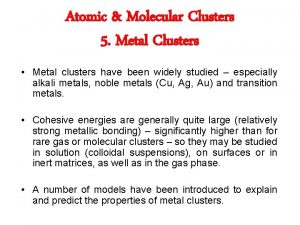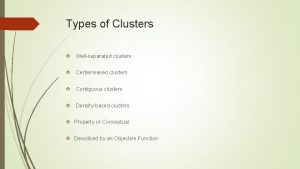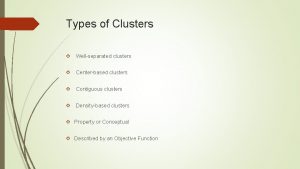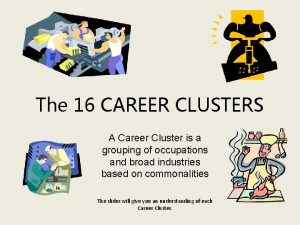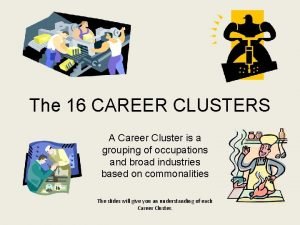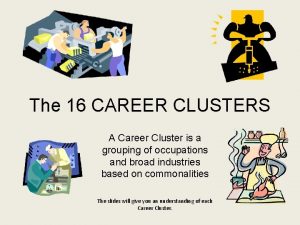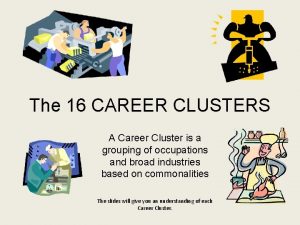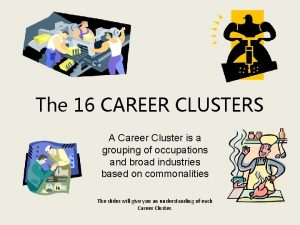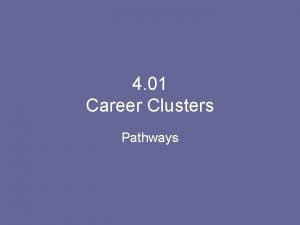Career Clusters 101 An Introduction to a Framework



























































- Slides: 59

Career Clusters® 101: An Introduction to a Framework for Impacting Students, Communities and the Economy Presented by: Date:

Implementation The Framework Purpose

Purpose

OPERATING PRINCIPLES OF CAREER CLUSTERS®

All Students have a Career Pathway. • Career pathways should match student interests and aptitudes. • Students voluntarily choose their own career pathway. • No student is locked into a track or career pathway involuntarily. • Career pathways extend into adulthood.

Students should be college-ready. Even if college is not the first destination after high school.

Career-ready is more than college-ready.

All students should have the opportunity for career awareness, career exploration and some level of career preparation in school (K-12).

Curriculum (including CTE) serves the needs of students’ career pathways.

RATIONALE

The Changing U. S. Workforce Professional 20% Source: Pathways to Prosperity, Harvard, February 2011

National Initiatives

Economic Realities Half of all newly created jobs in the U. S. will require postsecondary degree. Fastest growth will occur in jobs requiring an associate’s degree. Occupations 2008 -2018 1/3 of all job openings in the U. S. will require a postsecondary degree.

Continuing Effects of Globalization of Economy • Abundance • Automation • Asia

Continuing Effects of Globalization of Economy Jobs Pyramid Creative Work United States Developing Countries Routine Work by People Routine Work By Machines Source: www. skillscommission. org

Challenges Our Students Face • Engagement • Achievement • Transition

Engagement Dropout rates of 15 – 24 year olds who dropped out of grades 10 – 12 between 1972 - 2009 8 7 6 5 4 3 2 1 74 19 76 19 78 19 80 19 82 19 84 19 86 19 88 19 90 19 92 19 94 19 96 19 98 20 00 20 02 20 04 20 06 20 08 19 19 72 0

Why Do They Leave? Source: “The Silent Epidemic: Perspectives of High School Dropouts” Civic Enterprises, 2006

Challenges Our Students Face • Engagement • Achievement • Transition

High School Achievement 350 300 Trends in average reading scores for students ages 9, 13 and 17 (1971 - 2008) 285 250 255 285 258 200 208 215 290 288 257 260 258 285 259 212 211 212 219 Age 13 150 Age 17 100 50 0 1971 1975 1980 1984 1988 1990 1992 1994 1996 1999 2004 2008 Source: US DOE NAEP Scores, selected years

Challenges Our Students Face • Engagement • Achievement • Transition

Transitions from High School

Global Competition Percentage of population with a postsecondary credential 57. 9 48. 8 40. 0 55 -64 25 -34 College Board Report 2011 Source: Organisation for Economic Co-operation and Development, 2010

College Degrees Related to Unemployment • New Bachelor’s degree - 8. 9 % • Recent high school diploma - 22. 9 % • Recent high school dropouts - 31. 5% Generally higher in non-technical majors: • Arts (11. 1 percent) • Humanities and Liberal Arts (9. 4 percent) • Social Science (8. 9 percent) • Law and Public Policy (8. 1 percent) Relatively low (5. 4 percent) for recent college students who majored in Healthcare and Education because these majors are attached to stable or growing industry sectors.

Implementation The Framework Purpose

The 16 Career Clusters® ®

An Example Agriculture, Food & Natural Resources Career Cluster® The production, processing, marketing, distribution, financing and development of agricultural commodities and resources including food, fiber, wood products, natural resources, horticulture and other plant and animal products/resources. • Food Products and Processing Systems Career Pathway • Plant Systems Career Pathway • Animal Systems Career Pathway • Power, Structural & Technical Systems Career Pathway • Natural Resources Systems Career Pathway • Environmental Service Systems Career Pathway • Agribusiness Systems Career Pathway

An Example Career Cluster® Agriculture, Food & Natural Resources Career Pathway Food Products & Processing Systems Plant Systems Animal Systems Agribusiness Systems Power, Structural & Technical Systems Natural Resources Systems Environmental Service Systems Career Options Aquacultural Managers Farm Labor Contractors Precision Agriculture Technicians Crop & Livestock Managers Food Scientists

Every Career Cluster® and Career Pathway contains careers that can appeal to all students regardless of background, race, ethnicity, gender or age, which are… • High-Skill • High-Demand • High-Wage

Options in Every Career Cluster® Advanced Degree Architect, Materials Researcher, Urban Planner 4 -Year College Degree Construction Manager, Cost Estimator, Facilities Engineer Technical Degree or Training High School only with on-the-job training Electrician, Surveyor, Architectural Draftsman, Safety Director Painter, Roofer, Insulation Installer, Framer Architecture and Construction Career Cluster® Source: O*Net Career information

Options in Every Career Cluster® Advanced Degree 4 -Year College Degree Animal Scientist, Economist, Biochemist Soil and Water Conservationist, Forester, Crop & Livestock Manager Technical Degree or Training Food Science Technician, Farmer or Rancher, Nursery Greenhouse Manager High School only with on-the-job training Grounds Maintenance Worker, Floral Designer, Tree Trimmer and Pruner Agriculture, Food & Natural Resources Career Cluster ® Source: O*Net Career information

Options in Every Career Cluster® Advanced Degree 4 -Year College Degree Organizational Behavior Studies, International Finance, Industrial Relations Sales Engineer, Appraiser, Energy Broker, Meeting & Convention Planner Technical Degree or Training Real Estate Broker, Fashion Designer, Travel Guide, Assessor High School only with on-the-job training Cashier, Stock Clerk, Counter & Rental Clerk, Telemarketer Marketing Career Cluster® Source: O*Net Career information

THE VALUE OF THE NATIONAL CAREER CLUSTERS® FRAMEWORK

Value of Career Clusters® • Clear and consistent model • Builds transferrable skills • Provides structure • Promotes seamless transition • Relevant and integrated approach • Apples to ALL students

What the Framework is NOT • • • Prescribed system Tracking students One-size-fits-all approach A goal in itself A model just for Career Technical Education programs and students

MODELS OF ADAPTING THE NATIONAL CAREER CLUSTERS® FRAMEWORK

Nebraska Adaptation Example

Maryland Adaptation Example Maryland’s system encompasses virtually all careers and levels of education – from entry level to professional level – in the following 10 career clusters:

Colorado and Florida Adaptation

Implementation The Framework Purpose

CAREER CLUSTERS® AND THE EDUCATION SYSTEM

Influence on the System Employment: Career Advancement Continuing Education and Lifelong Learning Postsecondary: Career Preparation Achieving credentials: college, certification, apprenticeship, military 9 -12: Programs of Study Related to a Career Goal Academics and technical courses, intensive guidance, individual graduation plans Grade 8: Career Exploration and Transition Develop graduation plans based upon personal interest/cluster areas 6 -8: Initial Career Exploration Discovering interest areas K-5: Understanding the Importance and Value of Work and Jobs Introduction to the world of careers

Common Core State Standards & Common Career Technical Core

Application of Career Clusters® • Elementary, Middle and Comprehensive High Schools • Career Academies • Small Learning Communities • Magnet Schools • Regional Career Centers • Community Colleges • Workforce Training • Early and Middle College

Benefits Learners Teachers & Faculty Schools & Colleges Parents Business School Counselors

CAREER CLUSTERS® AND RELATIONSHIP TO CTE

THEN Vocational Education NOW/FUTURE Career Technical Education For a Few Students For All Students For a Few “Jobs” For All Careers 6 to 7 “Program Areas” 16 Career Clusters® 79 Career Pathways Aligns/Supports Academics In lieu of Academics High-School Focused High School and College Partnerships

Supporting the Current and Future Goals of Perkins Legislation • Attend to high-skill, high-wage, high-demand career fields of modern economy • Focus on programs of study – not just programs and courses • Include more rigor and more integration of academics in CTE programs • Enact better transitions from high school • Promote partnerships

Does this mean the end of high school CTE programs like Family and Consumer Sciences or Business Education? Is this the beginning of national curriculum and testing in CTE? How does this change the type of student that CTE serves in schools?

TOOLS

Free Resources Source: www. careertech. org

Posters and Brochures

PROGRAMS OF STUDY – THE PRIMARY DRIVER OF IMPLEMENTATION

Why Programs of Study? http: //www. careertech. org/career-clusters/programs-study. html

Programs of Study (POS) • Incorporate and align secondary and postsecondary education elements. • Include academic and CTE content in a coordinated, non-duplicative progression of courses. • Offer the opportunity, if appropriate, for secondary students to acquire postsecondary credits. • Lead to an industry-recognized credential or certificate at the postsecondary level, or an associate or baccalaureate degree. • Support the POS 10 Component Framework tenants.

More than…

The 10 Components of a Rigorous Program of Study

Questions? Implementation The Framework Purpose

THANK YOU!
 79 career clusters in the national career cluster framework
79 career clusters in the national career cluster framework Missouri connections career clusters
Missouri connections career clusters Career clusters framework
Career clusters framework Iseek career cluster interest survey
Iseek career cluster interest survey Career cluster definition
Career cluster definition Define career cluster
Define career cluster Mcis career clusters
Mcis career clusters Mcis career cluster inventory
Mcis career cluster inventory Why are career clusters important?
Why are career clusters important? What are the 16 clusters
What are the 16 clusters Georgia career clusters
Georgia career clusters Maryland career clusters
Maryland career clusters Onet career clusters
Onet career clusters Mn career clusters
Mn career clusters Mn career clusters
Mn career clusters Virginia career clusters
Virginia career clusters Vawizard.org
Vawizard.org Formulas for career success: résumés - assessment
Formulas for career success: résumés - assessment College and career competency framework
College and career competency framework Health informatics career framework
Health informatics career framework Skills for health career framework
Skills for health career framework Dispositional framework vs regulatory framework
Dispositional framework vs regulatory framework Theoretical framework vs conceptual framework
Theoretical framework vs conceptual framework Conceptual framework
Conceptual framework Theoretical framework
Theoretical framework Dispositional framework vs regulatory framework
Dispositional framework vs regulatory framework Theoretical framework
Theoretical framework Ihi l 101
Ihi l 101 Salesforce 101: introduction to salesforce kurs
Salesforce 101: introduction to salesforce kurs It 101 - introduction to computing
It 101 - introduction to computing Cs101 lecture 1
Cs101 lecture 1 It 101 introduction to computing
It 101 introduction to computing Qi 101: introduction to health care improvement
Qi 101: introduction to health care improvement Career development interventions
Career development interventions Enrichment clusters
Enrichment clusters Springboard jmu
Springboard jmu Population distribution
Population distribution Gram positive cocci
Gram positive cocci 15 grand strategies with examples
15 grand strategies with examples Obsessive personality disorder
Obsessive personality disorder Sanjay ghemawat
Sanjay ghemawat Linux os high performance
Linux os high performance Marking bad clusters data hiding technique
Marking bad clusters data hiding technique 1. the space between traffic clusters is called a(n)
1. the space between traffic clusters is called a(n) Vowel clusters examples
Vowel clusters examples Design principles of computer clusters
Design principles of computer clusters Cartogram world population
Cartogram world population Danielson clusters
Danielson clusters Maximal onset principle example
Maximal onset principle example Noun form of fragmented
Noun form of fragmented Parts of a wavelength
Parts of a wavelength Types of waves quad clusters answer key
Types of waves quad clusters answer key Virtualization of clusters in cloud computing
Virtualization of clusters in cloud computing Rit cs clusters
Rit cs clusters Two almond shaped neural clusters
Two almond shaped neural clusters Short entrance lane
Short entrance lane Dx clusters
Dx clusters Personality disorder clusters mnemonic
Personality disorder clusters mnemonic Two almond shaped neural clusters
Two almond shaped neural clusters Galaxy clusters
Galaxy clusters

